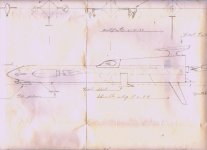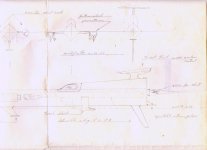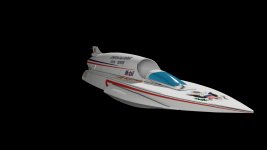In his new book on the water speed record, Doug Ford (Lockheed engineer and former aerodynamicist for the Miss Budweiser team) discusses the rocket boat design proposed in 1987 by my late friend Arvil Porter.

"ARVIL PORTER AND HIS ROCKET BOAT CONCEPT
As was the case for Donald Campbell, Sir Henry Seagrave, and John Cobb, some people interested in the world land speed record have been similarly interested in setting a new world water speed record. Such was a very talented man by the name of Arvil Porter, who was an expert in hydrogen peroxide rocket motors.
Arvil had built several ultralight, rocket-powered dragsters, a rocket powered motor cycle, and most recently was working on the rocket motors for Waldo Stakes’ rocket-powered land speed record vehicle, Sonic Wind. Porter had watched the water speed record attempts by Donald Campbell in Bluebird K7, Lee Taylor in both Hustler and Discovery II, and the current record holder Ken Warby in Spirit of Austrailia. He became convinced that he could design a better water speed record craft. His thinking was that a lightweight, rocket-powered boat, riding on skis would be able to safely break the World Unrestricted Water Speed Record. In 1987, Porter drew a sketch of his idea for a very small, ultralight, rocket-powered water speed record boat. His concept was clearly
unique, and a complete departure from anything that had been done before, although U.S. Discovery II was also powered by hydrogen peroxide rocket. Arvil’s concept for a record attempt boat capable of safely attaining over 300 miles per hour vehicle was a very light craft weighing only about 1,000 pounds, powered by three hydrogen peroxide rocket motors. According to Franklin Ratliff, a longtime friend, Porter specified a 4,000 pound thrust motor in the center of the aft fuselage and two 3,000 pound thrust motors on each side forward near the bow. The hull would ride on three ski-like planing surfaces; one forward and one on each side about two thirds of the way back on the fuselage. Pitch attitude would be controlled by an underwater hydrofoil positioned just behind the front ski, and by a horizontal stabilizer mounted on top of the cowling at the rear. Directional control would be provided by a rudder at the rear.
Arvil Porter’s original sketch of his water speed record boat concept
Scanned copy courtesy of Franklin Ratliff"

"ARVIL PORTER AND HIS ROCKET BOAT CONCEPT
As was the case for Donald Campbell, Sir Henry Seagrave, and John Cobb, some people interested in the world land speed record have been similarly interested in setting a new world water speed record. Such was a very talented man by the name of Arvil Porter, who was an expert in hydrogen peroxide rocket motors.
Arvil had built several ultralight, rocket-powered dragsters, a rocket powered motor cycle, and most recently was working on the rocket motors for Waldo Stakes’ rocket-powered land speed record vehicle, Sonic Wind. Porter had watched the water speed record attempts by Donald Campbell in Bluebird K7, Lee Taylor in both Hustler and Discovery II, and the current record holder Ken Warby in Spirit of Austrailia. He became convinced that he could design a better water speed record craft. His thinking was that a lightweight, rocket-powered boat, riding on skis would be able to safely break the World Unrestricted Water Speed Record. In 1987, Porter drew a sketch of his idea for a very small, ultralight, rocket-powered water speed record boat. His concept was clearly
unique, and a complete departure from anything that had been done before, although U.S. Discovery II was also powered by hydrogen peroxide rocket. Arvil’s concept for a record attempt boat capable of safely attaining over 300 miles per hour vehicle was a very light craft weighing only about 1,000 pounds, powered by three hydrogen peroxide rocket motors. According to Franklin Ratliff, a longtime friend, Porter specified a 4,000 pound thrust motor in the center of the aft fuselage and two 3,000 pound thrust motors on each side forward near the bow. The hull would ride on three ski-like planing surfaces; one forward and one on each side about two thirds of the way back on the fuselage. Pitch attitude would be controlled by an underwater hydrofoil positioned just behind the front ski, and by a horizontal stabilizer mounted on top of the cowling at the rear. Directional control would be provided by a rudder at the rear.
Arvil Porter’s original sketch of his water speed record boat concept
Scanned copy courtesy of Franklin Ratliff"
Attachments
Last edited:




